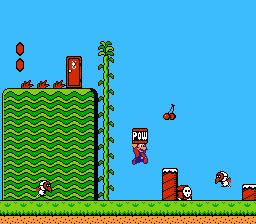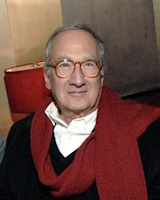I remember the day my older brothers got a Nintendo Entertainment System. As they had birthdays in April and March, my parents got them the console as a gift for both of them. I don't remember what year it was, but it had
Super Mario Bros. 3 as the included game.
I didn't get to play it much, I was the little brother just watching them swap turns between Mario and Luigi as Player 1 and Player 2, as the characters traveled a fantastic landscape, meeting fantastic enemies, some with vulnerabilities and others who were nearly invulnerable unless you had a power star.
In time, they picked up a few other games, including the classic Super Mario Bros. and Duck Hunt cartridge. They only occasionally rented Super Mario Bros. 2 which was my actual favorite of the NES trilogy. Later they also got a Super Nintendo Entertainment System with the mother of them all cartridges: Super Mario All-Stars and Super Mario World.
It wasn't until years later I got to play the games for myself through emulation. Today, I can easily play many Mario classics and new titles on my Switch, the first gaming console I owned myself.
I knew early on that Mario appeared in other games. Some I got to see played, others I didn't. There were puzzle games like Yoshi, Yoshi Cookie and Dr. Mario. Mario also appeared in other mediums, branded on merchandise aimed at kids, from socks and underwear to toothpaste and shampoo as well as toys.
Mario had also featured in a variety of TV shows,
The Super Mario Bros. Super Show,
The Adventures of Super Mario Bros. 3 and
Super Mario World presented animated adventures of Mario and Luigi and their friends in adventures based on the games, the writers and animators imagining the world of the games a little further than what you could get through in an 8-bit or 16-bit platform adventure. There were also Mario comics, similarly imagining the Mushroom Kingdom.
So, let's step out of my experience with the Mario franchise to its history. Nintendo was stepping out of toys into making video games and tried to license
Popeye for a video game: the player would control Popeye, jumping over obstacles and climbing up platforms to rescue Olive Oyl from Bluto. When they weren't able to secure the rights, they reworked the concept with new characters: Bluto became a giant gorilla they named Donkey Kong. Olive Oyl would be replaced by a girl named Pauline, and the player would control a red and blue-clad carpenter who got the name "Jump Man."
Donkey Kong became an arcade hit.
Jump Man would return as the villain of Donkey Kong Jr., as you controlled Donkey Kong's young son trying to free his father from Jump Man's imprisonment of him.
Donkey Kong had a third game, but Jump Man wasn't in it, instead spinning off into his own arcade game:
Mario Bros. in which he got the name Mario and his brother Luigi (wearing green instead of red to differentiate him). They got their own game as a launch title for the NES console in the US,
Super Mario Bros. which introduced concepts that would become iconic for the franchise: the Mushroom Kingdom, mushrooms, flowers and stars that game Mario and Luigi special abilities, Bowser, the host of enemies, the Mushroom Retainers (later known as Toad) and the Princess. (In the US, she was called Princess Toadstool. In Japan, she was always Princess Peach, the name she eventually came around to in North America.)
The original manual of
Super Mario Bros. claims Bowser transformed the people of the Mushroom Kingdom into blocks and plants and Mario has to save the Princess who has the power to restore everything.
The original game didn't have a lot of variance in the world: overhead levels were set up different, creating increasingly difficult stages, but largely were the overhead land, largely on ground with some pits, some underground areas where the brothers fought enemies through a dungeon, underwater stages, stages where Mario had to jump from platform to platform, and every fourth stage was a castle where Mario would face off against an enemy disguised as Bowser, until the eighth "World" (each group of four levels) where you finally got to face off against Bowser for real and rescue the Princess.
Super Mario Bros. 2 is a divisive game in the fandom as there's two sequels to the first game. The "real" version was another game much like the first one with much harder challenges that wasn't released in the US until it was included in a "remastered" form as
The Lost Levels in
Super Mario All-Stars. What the US got as the sequel was a partly re-skinned and somewhat re-engineered game originally called
Doki Doki Panic, a game made for Japan's Dream Factory festival, now with Mario characters instead of the original characters who were part of the event's marketing. This game introduced Subcon, a kingdom Mario dreamed of, as well as recurring villains like Ninjis, Shy Guys, Birdo, Pokeys as well as a few who didn't pop up again. It also allowed you to play as Mario, Luigi, Peach or Toad for the first time, each having special abilities.
Super Mario Bros. 3 was a huge step forward for the games as they place Mario's adventures on an actual map as Mario and Luigi traveled through multiple lands, facing off against Bowser's children and restoring stolen magic wands to the kings of the lands before facing off against Bowser who has stolen Peach again. Suddenly, there were different worlds with themed variations: grasslands, desert, underwater, giants, clouds, ice, pipes and lava.
Then we got into the 16 bit era with
Super Mario World on the Super NES. Mario traveled through Dinosaur Land, a new land threatened by Bowser when he and Luigi were supposed to be on vacation with Peach. Assisted by a dinosaur named Yoshi (who Mario could ride, which offered a change in gameplay), they face Bowser, his children and a host of new and old villains.
As the games continued, the storytelling got more advanced. The launch game for Nintendo 64, Nintendo's first console with 3D-rendered graphics,
Super Mario 64 has Mario jump into paintings in Peach's enchanted castle (Bowser again) to enter stages that had different objectives each time you played.
The biggest world-building games occurred when Mario branched into RPGs with
Super Mario RPG: Legend of the Seven Stars, the
Paper Mario series and the
Mario & Luigi series. Now the characters had dialogue and more complex storylines. A lot of the original stories found in the original game manuals didn't really work with what was eventually established.
In addition to his platforming games which continued to find new challenges on each console they released on, Mario and his cast had other successful franchises like the Mario Kart racing series and Mario Party, and while Super Smash Brothers is actually a tournament fighting game for all of Nintendo's franchises, Mario and his cast are certainly featured.
So, how long before Mario made it into movies?
Very quickly. In fact, Mario's first movie was in 1986. It was an anime only released in Japan titled Super Mario Brothers: The Great Mission to Rescue Princess Peach. It only had the first Super Mario Bros. game to draw lore from. But 1993 brought a Hollywood-produced live action movie, Super Mario Bros. Starring Bob Hoskins as Mario and John Leguizamo as Luigi, it reimagined the lore of the games into a more family-friendly but very weird Blade Runner knockoff. It was a box office bomb and fans of the games hated it because it didn't embrace the wonderful world the games presented. It has since picked up a cult following, with sensibilities and knowledge of the behind the scenes stories helping new audiences understand the challenge the movie had.
That movie also made Nintendo wary of licensing their games out to be made into movies. But now, thirty years later, we have The Super Mario Bros. Movie, created through a partnership with Nintendo and Illumination Animation.
Frankly, if we'd gotten this movie thirty years ago, my child self would have been over the moon in love with it.
The movie is based around the story we've largely understood from the first game and seen depicted in the opening of
The Super Mario Bros. Super Show's theme song: Mario and Luigi are plumbers in "our world" (Brooklyn) who wind up in the Mushroom Kingdom after going through a pipe they find while on a job, joining a campaign against Bowser.
There's just some twists: Princess Peach is not a damsel in distress now, vowing to save her kingdom of Toads from Bowser, appealing to the Kong nation (did I mention Donkey Kong eventually had his own spinoff and development that sometimes crossed back with Mario?) for aid. Given that the games have given us multiple instances of Peach being heroic (in Super Mario RPG, she even joins Mario's party and becomes one of the recommended members to have on hand, doing maximum damage with a frying pan), this is a welcome development, though some critics have decried this as being a "politically correct" or "woke" change. It makes Peach more interesting, so I'm all for it.
The movie is a load of fun with gags, lots of action and Easter eggs for fans of the franchise (one used to market the movie is a commercial for "Super Mario Bros. Plumbing" using a reworked
Super Show theme song). The characters are used to good effect. Even
Mario Kart winds up getting a tribute in the plot. One moment I had to applaud early on has Mario jump and run through
obstacles in Brooklyn, clearly paying tribute to the 2D platform origins
of the franchise. Peach also tests Mario with an obstacle course,
letting him try it again and again, much like how the games allow you to
try again. Even
The Great Mission to Rescue Princess Peach gets a reference.
If any element is underserved, it might be Luigi, who winds up quickly getting caught by Bowser's minions and held prisoner and isn't able to join the action until late in the movie. Yet it still gets him right by having him be more prone to getting scared but still joining Mario in his fight against Bowser. He recognizes the danger to himself more keenly than Mario, but is still willing to step up and fight.
There isn't a deep plot here, Mario and Luigi want to prove themselves to their family but aren't doing well in their new plumbing business, but then wind up saving a kingdom. The Mario games have never had deep storytelling, so it's not unfaithful to the franchise, though if they had found an angle for a deeper story, that wouldn't have been the worst thing.
If you're wanting a good time at the movies you can guiltlessly take your kids to, The Super Mario Bros. Movie is it.
And stick through the credits for a potential sequel hook!





















